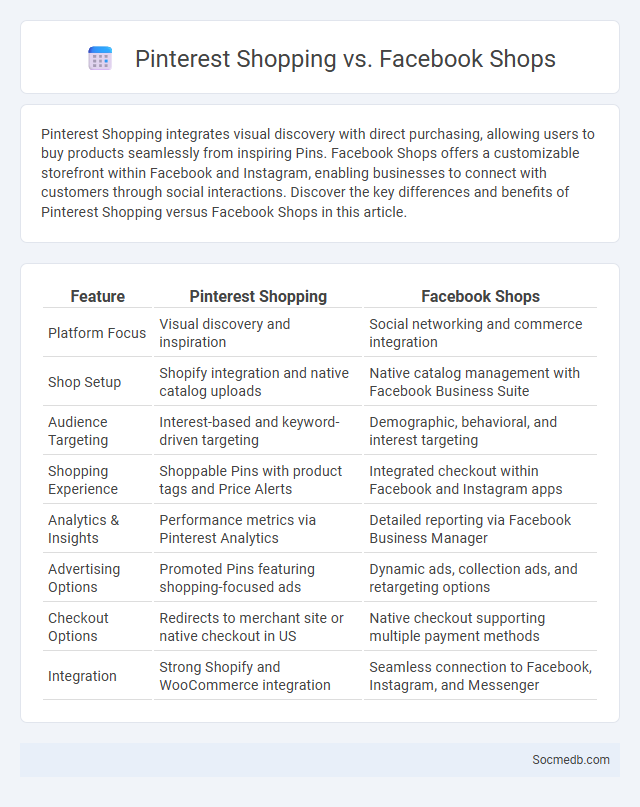
Photo illustration: Pinterest Shopping vs Facebook Shops
Pinterest Shopping integrates visual discovery with direct purchasing, allowing users to buy products seamlessly from inspiring Pins. Facebook Shops offers a customizable storefront within Facebook and Instagram, enabling businesses to connect with customers through social interactions. Discover the key differences and benefits of Pinterest Shopping versus Facebook Shops in this article.
Table of Comparison
| Feature | Pinterest Shopping | Facebook Shops |
|---|---|---|
| Platform Focus | Visual discovery and inspiration | Social networking and commerce integration |
| Shop Setup | Shopify integration and native catalog uploads | Native catalog management with Facebook Business Suite |
| Audience Targeting | Interest-based and keyword-driven targeting | Demographic, behavioral, and interest targeting |
| Shopping Experience | Shoppable Pins with product tags and Price Alerts | Integrated checkout within Facebook and Instagram apps |
| Analytics & Insights | Performance metrics via Pinterest Analytics | Detailed reporting via Facebook Business Manager |
| Advertising Options | Promoted Pins featuring shopping-focused ads | Dynamic ads, collection ads, and retargeting options |
| Checkout Options | Redirects to merchant site or native checkout in US | Native checkout supporting multiple payment methods |
| Integration | Strong Shopify and WooCommerce integration | Seamless connection to Facebook, Instagram, and Messenger |
Overview of Social Commerce Platforms
Social commerce platforms integrate e-commerce functionalities directly within social media networks, enabling seamless shopping experiences. Popular platforms like Instagram, Facebook Shops, and TikTok Shopping offer features such as in-app product listings, secure checkout, and personalized recommendations. Understanding how your audience interacts on these platforms can enhance engagement and drive sales effectively.
Key Features of Pinterest Shopping
Pinterest Shopping offers visual discovery with personalized recommendations based on your browsing behavior and interests. Its key features include product tagging in Pins, price tracking, and direct links to retailer websites for seamless purchasing. You can explore curated collections and shoppable catalogs that enhance your online shopping experience.
Core Capabilities of Facebook Shops
Facebook Shops enables businesses to create customizable online storefronts directly within Facebook and Instagram, streamlining the shopping experience for users. It supports seamless integration with inventory management systems and payment processing, facilitating efficient order fulfillment. Advanced analytics and customer insights empower merchants to tailor marketing strategies and enhance customer engagement.
Shopping Integration: Definition and Scope
Shopping integration on social media refers to the seamless incorporation of e-commerce features within social platforms, enabling users to browse, select, and purchase products without leaving the app. This scope includes shoppable posts, in-app checkout, product tagging, and personalized recommendations driven by AI algorithms. By leveraging shopping integration, your social media presence transforms into a direct sales channel, enhancing customer engagement and streamlining the buyer journey.
User Experience Comparison
User experience on social media platforms varies significantly based on interface design, content relevance, and ease of interaction. Platforms like Instagram prioritize visual content with intuitive navigation, while Twitter emphasizes real-time updates and concise messaging, catering to different user preferences. Understanding these differences helps you choose the platform that best aligns with your communication style and engagement needs.
Audience Demographics and Reach
Social media platforms attract diverse audience demographics, with Facebook dominating users aged 25-34, while TikTok sees higher engagement from teens and young adults aged 16-24. Instagram boasts a strong presence among Millennials and Gen Z, offering brands rich targeting options to maximize reach in these groups. Leveraging detailed demographic data enables marketers to tailor content strategies that drive higher engagement and conversion rates.
Integration with E-commerce Platforms
Seamless integration of social media with e-commerce platforms enhances your online store's reach and drives customer engagement through targeted advertising and direct shopping features. Leveraging tools like shoppable posts, in-app checkout, and personalized product recommendations on platforms such as Instagram, Facebook, and TikTok boosts conversion rates and streamlines the customer journey. Optimizing this integration improves your sales funnel efficiency and provides valuable consumer insights for data-driven marketing strategies.
Advertising and Promotion Tools
Social media platforms offer a diverse range of advertising and promotion tools, including targeted ads, sponsored posts, and influencer partnerships designed to maximize brand visibility and engagement. Advanced analytics and audience segmentation enable precise campaign optimization, enhancing ROI by reaching specific demographics based on interests, behaviors, and location. Features such as shoppable posts and interactive stories further drive direct customer actions and sales conversions on platforms like Instagram, Facebook, and TikTok.
Analytics and Conversion Tracking
Social media analytics tools provide detailed insights into user behavior, engagement rates, and content performance, enabling businesses to refine their marketing strategies effectively. Conversion tracking measures the actions users take after interacting with social media ads or posts, such as website visits, purchases, or sign-ups, offering critical data for ROI calculation. Integrating analytics with conversion tracking ensures precise attribution of social media efforts to business outcomes, optimizing campaigns for higher conversions and increased revenue.
Best Use Cases for Each Platform
Instagram excels in visual storytelling, making it ideal for brands showcasing products through images and short videos to engage younger, trend-focused audiences. LinkedIn serves professionals by facilitating networking, job hunting, and sharing industry insights, perfect for B2B marketing and career growth. Twitter provides real-time updates and conversations, helping you connect with influencers and participate in trending discussions for brand visibility.
 socmedb.com
socmedb.com